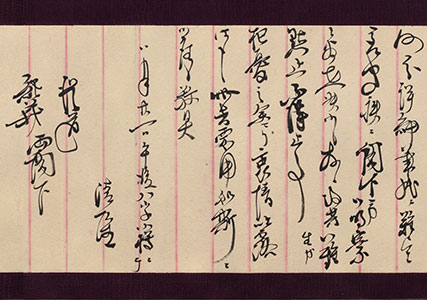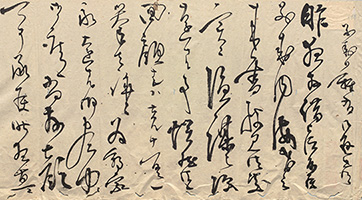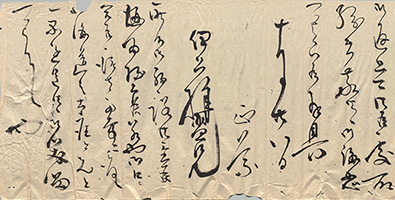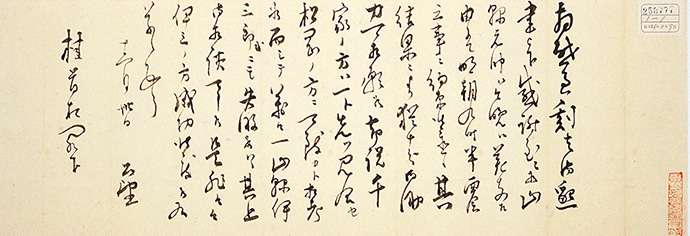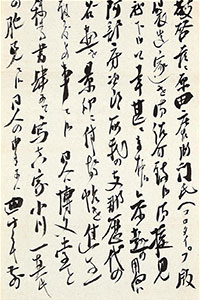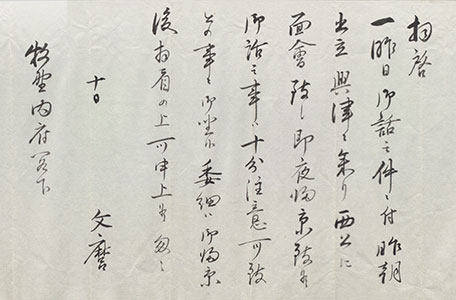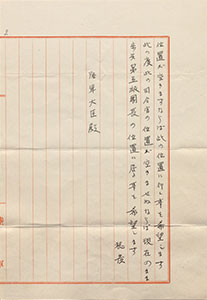Chapter 2 Past Prime Ministers
ITO Hirobumi, 1841-1909
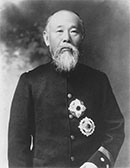 Ito was a politician. He served as the 1st, 5th, 7th, and 10th Prime Minister. He went to Shoka Sonjuku (a private school) established by Yoshida Shoin, and also studied in the United Kingdom. He participated in the anti-Shogunate movement. In the Meiji government, he established a cabinet system, and became the first Prime Minister in 1885, and worked for establishing the Constitution of the Empire of Japan and other institutions. Before and after the Sino-Japanese War, he formed a cabinet, a total of four times. He assumed positions including Chairman of the Privy Council, president of the Rikken Seiyukai (the Friends of Constitutional Government Party), and became the first Inspector General of Korea in 1905. He was assassinated in Harbin in 1909 by An Chung-gun who was an activist for the independence of Korea.
Ito was a politician. He served as the 1st, 5th, 7th, and 10th Prime Minister. He went to Shoka Sonjuku (a private school) established by Yoshida Shoin, and also studied in the United Kingdom. He participated in the anti-Shogunate movement. In the Meiji government, he established a cabinet system, and became the first Prime Minister in 1885, and worked for establishing the Constitution of the Empire of Japan and other institutions. Before and after the Sino-Japanese War, he formed a cabinet, a total of four times. He assumed positions including Chairman of the Privy Council, president of the Rikken Seiyukai (the Friends of Constitutional Government Party), and became the first Inspector General of Korea in 1905. He was assassinated in Harbin in 1909 by An Chung-gun who was an activist for the independence of Korea.
52 Ito Hirobumi shokan [draft], August 9, 1882[Ito Hirobumi Papers (No.1), Document: 22]![The folding of Ito Hirobumi shokan [draft]](../img/btn_digital.gif)
This is a letter (draft) written by Ito who was in Europe to Iwakura Tomomi, the u daijin (Minister of the Right). As a result of “a Political Change of 1881”, the Meiji government decided to shelve the introduction of the English-style parliamentary cabinet system advocated by Okuma Shigenobu, and introduced instead a German-style constitution which preserved the royal prerogative. Ito was sent to Europe from March 1882 to August the following year to study constitutions. He learned from Rudolf von Gneist who was a professor at the University of Berlin as well as Lorenz von Stein who was a professor at the University of Vienna, and started forming the Constitution of the Empire of Japan when he returned to Japan. In the letter, he says he plans to stay in Vienna for a little while longer and listen to Stein’s debate, etc.
KURODA Kiyotaka, 1840-1900
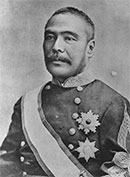 Kuroda was a politician and served as the second Prime Minister. He engaged in the conclusion of the Satsuma-Choshu Alliance with Sakamoto Ryoma and others, and served as a staff officer in the Boshin War and attacked Goryokaku. He made Enomoto Takeaki surrender but also worked to spare Enomoto’s life. He developed Hokkaido and concluded the Japan-Korea Treaty of Amity in 1876 as a minister extraordinary and plenipotentiary. He became the second Prime Minister in 1888 and worked for issuing the Constitution of the Empire of Japan but failed in negotiation with European countries and the Americas for treaty revision and resigned the following year. He was one of the genros (elder statesman).
Kuroda was a politician and served as the second Prime Minister. He engaged in the conclusion of the Satsuma-Choshu Alliance with Sakamoto Ryoma and others, and served as a staff officer in the Boshin War and attacked Goryokaku. He made Enomoto Takeaki surrender but also worked to spare Enomoto’s life. He developed Hokkaido and concluded the Japan-Korea Treaty of Amity in 1876 as a minister extraordinary and plenipotentiary. He became the second Prime Minister in 1888 and worked for issuing the Constitution of the Empire of Japan but failed in negotiation with European countries and the Americas for treaty revision and resigned the following year. He was one of the genros (elder statesman).
53 Kuroda Kiyotaka shokan, August 21, 1881[Modern Japanese Political History Materials Room Collection: 272]
This is a letter about the “Incident Concerning Sale of the Properties Owned by the Hokkaido Development Commission” written by Kuroda, who was a director of the Development Commission and a sangi (councilor), to Saigo Tsugumichi and Kawamura Sumiyoshi who also were sangi. The Hokkaido Development Commissioner was severely criticized by the public for attempting to sell the commission’s properties to officials and political merchants on extremely favorable terms. On the other hand, some people in the government were saying that Okuma Shigenobu and Fukuzawa Yukichi aligned with Mitsubishi which had financial interests were against selling them and swinging public opinion. In this letter, Kuroda is warning them not to fall into the trap of Okuma, Mitsubishi and their supporters.
YAMAGATA Aritomo, 1838-1922
 Yamagata was a politician who served as the 3rd and 9th Prime Minister. He went to Shoka Sonjuku (a private school) and participated in the sonno-joi undo (lit. the movement to revere the emperor and expel the barbarians) with Takasugi Shinsaku and others. After the Meiji Restoration, he visited Europe and studied their military systems, and worked to form the conscription system in Japan. He played an important role in establishing the army. He became the first head of the Military General Staff Office and Home Minister. He formed a cabinet twice. He also played a major role in both domestic and foreign affairs as a Marshal and genro (elder statesman).
Yamagata was a politician who served as the 3rd and 9th Prime Minister. He went to Shoka Sonjuku (a private school) and participated in the sonno-joi undo (lit. the movement to revere the emperor and expel the barbarians) with Takasugi Shinsaku and others. After the Meiji Restoration, he visited Europe and studied their military systems, and worked to form the conscription system in Japan. He played an important role in establishing the army. He became the first head of the Military General Staff Office and Home Minister. He formed a cabinet twice. He also played a major role in both domestic and foreign affairs as a Marshal and genro (elder statesman).
54 Yamagata Aritomo shokan, February 12, 1921[Tanaka Giichi Papers: 141]
This is a letter about the so-called “certain serious incident in the Imperial Palace” written by Yamagata to Tanaka Giichi who was from the same town as Yamagata. Kuninomiya Nagako, who was engaged to Prince Hirohito, was found to have possibly inherited color-blindness and Yamagata and others who were afraid to have a color-blind person in the Imperial family tried to break off the engagement. This issue became a serious political problem not only with opposition by Kuninomiya Family, but also with the anti-Yamagata movement by civil right-wing activists. The problem was settled two days before this letter was written by the announcement that there would be no change in the engagement.
MATSUKATA Masayoshi, 1835-1924
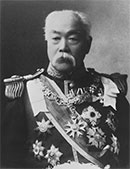 Matsukata was a politician. He served as the 4th and 6th Prime Minister. After working as an aide to Shimazu Hisamitsu, he was recognized by Okubo Toshimichi for his ability, and entered into the political arena after being the governor of Hita Prefecture. As an okurakyo (Finance Minister) and a Minister of Finance, he conducted a monetary policy called “Matsukata Financial Policy” and worked on paper money readjustment, tax increase, establishment of the Bank of Japan and the gold standard system. Meanwhile, he formed a cabinet twice. He had power as a genro (elder statesman) after Yamagata Aritomo died.
Matsukata was a politician. He served as the 4th and 6th Prime Minister. After working as an aide to Shimazu Hisamitsu, he was recognized by Okubo Toshimichi for his ability, and entered into the political arena after being the governor of Hita Prefecture. As an okurakyo (Finance Minister) and a Minister of Finance, he conducted a monetary policy called “Matsukata Financial Policy” and worked on paper money readjustment, tax increase, establishment of the Bank of Japan and the gold standard system. Meanwhile, he formed a cabinet twice. He had power as a genro (elder statesman) after Yamagata Aritomo died.
55 Matsukata Masayoshi shokan, October 28, 1881[Ito Hirobumi Papers (No.1), Letters: 164-181]
This is a letter written by Matsukata to Ito Hirobumi immediately after Matsukata was appointed as okurakyo (Finance Minister). In the letter, he mentions the letter of Utsumi Tadakatsu he borrowed and apologizes that he did not return it the night before. Also, he said, “You have made a great effort for our country on the Incident on 11th”. This is thought to be about “the Political Change of 1881” in which a conference was held on October 11 in the presence of the Emperor who had come back from Tohoku and Hokkaido, and decided on the establishment of a National Diet by 1890, dismissing Okuma Shigenobu and the bureaucrats in his group who were against it.
SAIONJI Kimmochi, 1849-1940
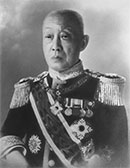 Saionji was a politician. The 12th and 14th Prime Minister. He was born in Tokudaiji Family, and was adopted by Saionji Family to take over the head of the family. He studied in France for ten years. After returning to Japan, he worked as a minister in various countries, vice-president of the House of Peers, Minister of Education, Minister of Foreign Affairs, Minister of Finance, etc. He formed a cabinet twice. He and Katsura Taro alternated their Cabinets, and it was called “Kei-en (Katsura/Saionji) era”. After the death of Matsukata Masayoshi, Saionji had power as the last genro (elder statesman) in nominating the next prime minister.
Saionji was a politician. The 12th and 14th Prime Minister. He was born in Tokudaiji Family, and was adopted by Saionji Family to take over the head of the family. He studied in France for ten years. After returning to Japan, he worked as a minister in various countries, vice-president of the House of Peers, Minister of Education, Minister of Foreign Affairs, Minister of Finance, etc. He formed a cabinet twice. He and Katsura Taro alternated their Cabinets, and it was called “Kei-en (Katsura/Saionji) era”. After the death of Matsukata Masayoshi, Saionji had power as the last genro (elder statesman) in nominating the next prime minister.
56 Saionji Kimmochi shokan, December 30, 1905[Katsura Taro Papers: 47-1]
This is a letter written by Saionji to Katsura Taro. At the end of the Meiji era, Saionji and Katsura alternated their Cabinets. Saionji was a president of the Rikken Seiyukai (the Friends of Constitutional Government Party) and Katsura had a connection with the Yamagata faction and had power over bureaucrats, the House of Peers and the military. This letter shows the process of personnel coordination. The Katsura Cabinet resigned en masse on December 21, and Saionji, the next Prime Minister, named Matsuoka Yasutake as the Minister of Agriculture and Commerce, and Yamagata Aritomo’s adopted son, Yamagata Isaburo, as Minister of Communication, asking for Katsura’s opinion.
HARA Takashi, 1856-1921
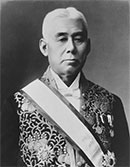 Hara was a politician. He was the 19th Prime Minister. His father was a feudal retainaer of the Nambu Domain. Hara worked as the Vice Minister of Foreign Affairs under Mutsu Munemitsu, the Minister of Foreign Affairs. After retiring from office, he joined the Rikken Seiyukai (the Friends of Constitutional Government Party) in 1900, and was elected as a member of the House of Representatives. He had the position of the Minister of Home Affairs under the first and second Saionji Cabinets. In 1918, he became the president of the Rikken Seiyukai, and the first Prime Minister who was an incumbent member of the House of Representatives. He established the first full-scale party cabinet and adopted positive policies such as establishing the transportation system and expanding education, but was assassinated in 1921 in Tokyo Station.
Hara was a politician. He was the 19th Prime Minister. His father was a feudal retainaer of the Nambu Domain. Hara worked as the Vice Minister of Foreign Affairs under Mutsu Munemitsu, the Minister of Foreign Affairs. After retiring from office, he joined the Rikken Seiyukai (the Friends of Constitutional Government Party) in 1900, and was elected as a member of the House of Representatives. He had the position of the Minister of Home Affairs under the first and second Saionji Cabinets. In 1918, he became the president of the Rikken Seiyukai, and the first Prime Minister who was an incumbent member of the House of Representatives. He established the first full-scale party cabinet and adopted positive policies such as establishing the transportation system and expanding education, but was assassinated in 1921 in Tokyo Station.
57 Hara Takashi shokan, June 18, 1914[Inoue Kaoru Papers: 246-4]
This is a letter written by Hara to Inoue Kaoru who was a genro (elder statesman) of the Choshu faction. In the letter, Hara reports that due to Saionji Kimmochi’s resignation from president of the Rikken Seiyukai (the Friends of Constitutional Government Party), he was asked to be the next president, and asks Inoue for support. Hara from the Nambu Domain is said to have had a strong spirit of defiance against the han-dominated government the Satsuma-Choshu clique due to his experience of being considered an enemy of the Imperial Court by them after the Meiji Restoration. On the other hand, he recognized the importance of democratic government by parties, and was considering the necessity of cooperating with powerful domain cliques to strengthen political parties. This letter shows his realistic side as a politician.
INUKAI Tsuyoshi, 1855-1932
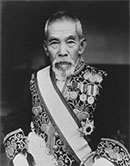 Inukai was a politician and served as the 29th Prime Minister. He was engaged in establishing the Rikken Kaishin-to (Constitutional Reform Party) in 1882, and was elected a member of the House of Representatives in 1890. (He was elected for 19 consecutive terms.) He played the central role in the party politics and established the Rikken Kokumin-to (Constitutional National Party) and the Kakushin Club. He supported politicians in exile such as Sun Yat-sen. In 1931, he formed the last party cabinet before the war, but was assassinated the following year (May 15 Incident). He was also famous as a calligrapher.
Inukai was a politician and served as the 29th Prime Minister. He was engaged in establishing the Rikken Kaishin-to (Constitutional Reform Party) in 1882, and was elected a member of the House of Representatives in 1890. (He was elected for 19 consecutive terms.) He played the central role in the party politics and established the Rikken Kokumin-to (Constitutional National Party) and the Kakushin Club. He supported politicians in exile such as Sun Yat-sen. In 1931, he formed the last party cabinet before the war, but was assassinated the following year (May 15 Incident). He was also famous as a calligrapher.
58 Inukai Tsuyoshi shokan, July 6, [ca. 1925-1931][Makino Nobuaki Papers, Letters: 124-1]
This is a letter written by Inukai to Makino Nobuaki who was the second son of Okubo Toshimichi and was the Lord Keeper of the Privy Seal. It was written when Inukai was in his 70s’. It introduces Harada Shozaemon who established Hakubundo in 1869. He supported Inukai Tsuyoshi and Ozaki Yukio and others who were working for realization of Constitutionalism and establishment of the National Diet through publishing materials from Hakubundo and by providing financial support.
KONOE Fumimaro, 1891-1945
 Konoe was a politician and served as the 34th, 38th and 39th Prime Minister. He was the 30th head of the Konoe Family, an important court noble (kazoku). After being President of the House of Peers, etc., he became Prime Minister in 1937 at the age of 47. He formed the cabinet two other times. He strengthened the war regime by establishing the National General Mobilization Act, concluding the Tripartite Pact with Germany and Italy and establishing the Taisei Yokusankai (the Imperial Rule Assistance Association). After losing the war, he was designated as a war criminal, and committed suicide by taking poison.
Konoe was a politician and served as the 34th, 38th and 39th Prime Minister. He was the 30th head of the Konoe Family, an important court noble (kazoku). After being President of the House of Peers, etc., he became Prime Minister in 1937 at the age of 47. He formed the cabinet two other times. He strengthened the war regime by establishing the National General Mobilization Act, concluding the Tripartite Pact with Germany and Italy and establishing the Taisei Yokusankai (the Imperial Rule Assistance Association). After losing the war, he was designated as a war criminal, and committed suicide by taking poison.
59 Konoe Fumimaro shokan, July 10, 1927[Makino Nobuaki Papers, Letters: 224-1]
This is a letter written by Konoe to Makino Nobuaki who was the Lord Keeper of the Privy Seal. In the letter, Konoe says, “I left yesterday morning and went to Okitsu to see Saiko on the issue you talked about the day before yesterday”. It does not mention the details, but “Saiko” means Saionji Kimmochi (Duke). Saionji was in the position to provide advice to the Emperor on major policy decisions and electing a prime minister, and to provide acknowledgement to the government.
The days when letters were delivered by messengers rather than postman
Most of the letters displayed in this digital exhibition were delivered long before the introduction of the postal system.
Many of these letters were delivered by messengers, who travelled long distances on foot to accomplish their errands. Sometimes a letter would contain a description of the messenger, as in Materials 21 Ryutei Tanehiko. Often, a reply would be written immediately and given to the messenger to deliver, as in Materials 17 Hirata Atsutane.
This practice continued even after the postal system was officially established in 1871. In some cases, this was because a letter was considered an informal courtesy visit made on behalf of the sender. Another reason was to ensure confidentiality by sending information with a trusted messenger.
Prince Higashikuni Naruhiko, 1887-1990
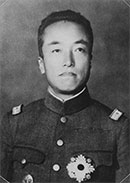 He was a politician and the 43th Prime Minister. He formed the first cabinet comprised of Imperial family members on August 17, 1945, immediately after the war ended. He signed the Instrument of Surrender with the Allied Nations, called for the breakup of the army and navy. On the other hand, he resisted the Allies’ policy and the Cabinet resigned with the shortest reign of 54 days. He changed his name to Higashikuni Naruhiko after he renounced his Imperial status in October 1947. He is known for saying at the press conference (August 28, 1945) after becoming Prime Minister, about “national confession of Japanese war guilt” as a first step of reconstruction and unity of the country.
He was a politician and the 43th Prime Minister. He formed the first cabinet comprised of Imperial family members on August 17, 1945, immediately after the war ended. He signed the Instrument of Surrender with the Allied Nations, called for the breakup of the army and navy. On the other hand, he resisted the Allies’ policy and the Cabinet resigned with the shortest reign of 54 days. He changed his name to Higashikuni Naruhiko after he renounced his Imperial status in October 1947. He is known for saying at the press conference (August 28, 1945) after becoming Prime Minister, about “national confession of Japanese war guilt” as a first step of reconstruction and unity of the country.
60 Higashikuninomiya Naruhiko o shokan, ca. 1932[Araki Sadao Papers: 21]
This is a letter written by Prince Higashikuni Naruhiko when he was an army major general to Araki Sadao who was the War Minister. In the letter, he is requesting to move him not to the General Staff Main Office but to the garrison for the independence of the South Manchuria Railway. This is thought to be due to his strong interest in the army’s desire to occupy Manchuria and Mongolia. His attitude as a military man was supported by some in the army.
The transition from writing brush to pen
The fountain pen was first imported to Japan in 1884. In those days, fountain pens did not have a modern split nib but rather a wire nib. It was not long, however, before the present form of the fountain pen came into use. One factor that contributed to the wide-spread use of the fountain pen was that, during the first Sino-Japanese War, they were supplied to military officers, because they were easier to handle than a writing brush on a warship. Additionally, as domestic production of western paper was growing more rapidly than that of washi (Japanese paper) in the 1890s and 1900s. The introduction of penmanship to the educational curriculum during the Taisho era also contributed to the transition away from the use of the writing brush on washi and the expanded use of the fountain pen on western paper.
Coincidentally, the modern ball-point pen with high-viscosity ink held in a tube-shaped reservoir was developed in Hungary in 1943.
YOSHIDA Shigeru, 1878-1967
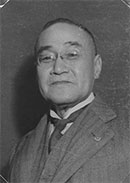 Yoshida was a politician. He was the 45th, 48th, 49th, 50th and 51st Prime Minister. He was a son-in-law of Makino Nobuaki who was a diplomat and a politician. He worked as a Vice Minister of Foreign Affairs, Ambassador to Italy and to the United Kingdom, Minister of Foreign Affairs in the Cabinet of Prince Higashikuni Naruhiko and the Shidehara Cabinet. After forming his first cabinet in 1946, he became the Prime Minister for a total of five times. He concluded the San Francisco Peace Treaty and the Japan-U.S. Security Treaty. He was known for his authoritarian behavior with great power even after his resignation from politics.
Yoshida was a politician. He was the 45th, 48th, 49th, 50th and 51st Prime Minister. He was a son-in-law of Makino Nobuaki who was a diplomat and a politician. He worked as a Vice Minister of Foreign Affairs, Ambassador to Italy and to the United Kingdom, Minister of Foreign Affairs in the Cabinet of Prince Higashikuni Naruhiko and the Shidehara Cabinet. After forming his first cabinet in 1946, he became the Prime Minister for a total of five times. He concluded the San Francisco Peace Treaty and the Japan-U.S. Security Treaty. He was known for his authoritarian behavior with great power even after his resignation from politics.
61 Yoshida Shigeru shokan, May 3, 1947[Makino Nobuaki Papers, Letters: 659-54]
This is a letter from Yoshida who was a Prime Minister and the leader of the Jiyu-to (Liberal Party) to Makino Nobuaki who was his father-in-law. Prior to the entry into force of the new Constitution on May 3, 1947, the first House of Councillors election was held on April 20, and the second House of Representatives election after the war was held on April 25 in order to form the first Diet. In the House of Representatives election, no party was able to win a majority. Nihon Shakai-to (Japan Socialist Party) of Japan, which became the first party, elected Katayama Tetsu as its head and organized a coalition cabinet with the Minshu-to (Democratic Party) of Japan and the Kokumin Kyodo-to (National Cooperative Party). After the election, Yoshida, who decided to hand over the reins of government said, “It is important to leave in a matter-of-fact way.” expressing himself ready to leave so that the Nihon Shakai-to would be able to take over without problem.
HATOYAMA Ichiro, 1883-1959
 Hatoyama was a politician, and the 52nd, 53rd and 54th Prime Minister. He became a city council member of the Tokyo City Assembly and a member of the House of Representatives, and became Minister of Education under the Inukai Cabinet and the Saito Cabinet. After the war, he formed the Nihon Jiyu-to (Japan Liberal Party) and became its president, but was purged from public service immediately before the cabinet formation in 1946. After returning to the Diet, he formed a cabinet as the president of the Nihon Minshu-to (Japan Democratic Party). The Jiyu Minshu-to (Liberal Democratic Party) was formed during his service and he became its first president. In 1956, he signed the Soviet-Japanese Joint Declaration of 1956 and restored diplomatic ties.
Hatoyama was a politician, and the 52nd, 53rd and 54th Prime Minister. He became a city council member of the Tokyo City Assembly and a member of the House of Representatives, and became Minister of Education under the Inukai Cabinet and the Saito Cabinet. After the war, he formed the Nihon Jiyu-to (Japan Liberal Party) and became its president, but was purged from public service immediately before the cabinet formation in 1946. After returning to the Diet, he formed a cabinet as the president of the Nihon Minshu-to (Japan Democratic Party). The Jiyu Minshu-to (Liberal Democratic Party) was formed during his service and he became its first president. In 1956, he signed the Soviet-Japanese Joint Declaration of 1956 and restored diplomatic ties.
62 Hatoyama Ichiro shokan, September 2, 1940[Ando Masazumi Papers: 571-4]
This is a letter written by Hatoyama to Ando Masazumi. It was written when the movement of the shintaisei (the national political system) Preparatory Committee was being monitored with the establishment of the Taisei Yokusankai (the Imperial Rule Assistance Association) expected in October 1940. Ando was a politician who worked as the Secretary-General of the Rikken Seiyukai (the Friends of Constitutional Government Party), but he did not join the Taisei Yokusankai, and he ran the election with no endorsement along with Hatoyama in the Yokusan Senkyo (the general election of 1942) and was elected. In this letter, Hatoyama praises Ando for opposing the new administration and said, “You have restored your reputation. You are quite a man”. But he also said, “The time will come.” and tells him it is also necessary to have self-control. Hatoyama himself lived a life of a recluse in Karuizawa for several years until the war ended.



![Ito Hirobumi shokan [draft]](img/img_s2_1_01.jpg)
